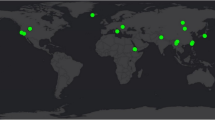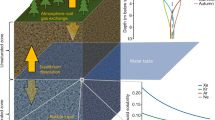Abstract
Noble-gas concentrations in ground water have been used as a proxy for past air temperatures1,2,3,4,5,6,7, but the accuracy of this approach has been limited by the existence of a temperature-independent component of the noble gases in ground water, termed ‘excess air’, whose origin and composition is poorly understood7,8,9. In particular, the evidence from noble gases in a Brazilian aquifer for a cooling of more than 5 °C in tropical America during the Last Glacial Maximum4 has been called into question9. Here we propose a model for dissolved gases in ground water, which describes the formation of excess air by equilibration of ground water with entrapped air in quasi-saturated soils10,11,12. Our model predicts previously unexplained noble-gas data sets, including the concentration of atmospheric helium, and yields consistent results for the non-atmospheric helium isotopes that are used for dating ground water. Using this model of excess air, we re-evaluate the use of noble gases from ground water for reconstructing past temperatures. Our results corroborate the inferred cooling in Brazil during the Last Glacial Maximum4, and indicate that even larger cooling took place at mid-latitudes.
This is a preview of subscription content, access via your institution
Access options
Subscribe to this journal
Receive 51 print issues and online access
$199.00 per year
only $3.90 per issue
Buy this article
- Purchase on Springer Link
- Instant access to full article PDF
Prices may be subject to local taxes which are calculated during checkout


Similar content being viewed by others
References
Mazor, E. Paleotemperatures and other hydrological parameters deduced from gases dissolved in groundwaters, Jordan Rift Valley, Israel. Geochem. Cosmochim. Acta 36, 1321–1336 ( 1972).
Andrews, J. N. & Lee, D. J. Inert gases in groundwater from the Bunter Sandstone of England as indicators of age and palaeoclimatic trends. J. Hydrol. 41, 233–252 (1979).
Stute, M. & Schlosser, P. in Climate Change in Continental Isotopic Records (eds Swart, P. K., Lohmann, K. C., McKenzie, J. & Savin, S.) 89–100 (American Geophysical Union, Washington DC, 1993).
Stute, M. et al. Cooling of tropical Brazil (5 °C) during the Last Glacial Maximum. Science 269, 379– 383 (1995).
Beyerle, U. et al. Climate and groundwater recharge during the last glaciation in an ice-covered region. Science 282, 731 –734 (1998).
Weyhenmeyer, C. E. et al. Cool glacial temperatures and changes in moisture source recorded in Oman groundwaters. Science 287, 842– 845 (2000).
Stute, M. & Schlosser, P. in Environmental Tracers in Subsurface Hydrology (eds Cook, P. & Herczeg, A. L.) 349– 377 (Kluwer Academic, Boston, 2000).
Heaton, T. H. E. & Vogel, J. C. “Excess air” in groundwater. J. Hydrol. 50, 201–216 (1981).
Ballentine, C. J. & Hall, C. M. An inverse technique for calculating paleotemperatures and other variables using noble gas concentrations in groundwater. Geochim. Cosmochim. Acta 63, 2315–2336 (1999).
Christiansen, J. E. Effect of entrapped air upon the permeability of soils. Soil Sci. 58, 355–365 ( 1944).
Fayer, M. J. & Hillel, D. Air encapsulation: 1. Measurement in a field soil. Soil Sci. Soc. Am. J. 50, 568–572 (1986).
Faybishenko, B. A. Hydraulic behavior of quasi-saturated soils in the presence of entrapped air: Laboratory experiments. Wat. Resour. Res. 31, 2421–2435 (1995).
Lehmann, B. E. & Purtschert, R. Radioisotope dynamics – the origin and fate of nuclides in groundwater. Appl. Geochem. 12, 727–738 (1997).
Schlosser, P., Stute, M., Sonntag, C. & Münnich, K. O. Tritiogenic 3He in shallow groundwater. Earth Planet. Sci. Lett. 94, 245–256 (1989).
Aeschbach-Hertig, W. et al. A 3H/3He study of ground water flow in a fractured bedrock aquifer. Ground Wat. 36 , 661–670 (1998).
Dunkle Shapiro, S., Rowe, G., Schlosser, P., Ludin, A. & Stute, M. Tritium-helium 3 dating under complex conditions in hydraulically stressed areas of a buried-valley aquifer. Wat. Resour. Res. 34, 1165–1180 (1998).
Beyerle, U. et al. Infiltration of river water to a shallow aquifer investigated with 3H/3He, noble gases and CFCs. J. Hydrol. 220, 169–185 (1999).
Solomon, D. K., Hunt, A. & Poreda, R. J. Source of radiogenic helium 4 in shallow aquifers: Implications for dating young groundwater. Wat. Resour. Res. 32, 1805–1813 (1996).
Osenbrück, K., Lippmann, J. & Sonntag, C. Dating very old pore waters in impermeable rocks by noble gas isotopes. Geochim. Cosmochim. Acta 62, 3041–3045 (1998).
Heaton, T. H. E., Talma, A. S. & Vogel, J. C. Origin and history of nitrate in confined groundwater in the western Kalahari. J. Hydrol. 62, 243–262 (1983).
Wilson, G. B. & McNeill, G. W. Noble gas recharge temperatures and the excess air component. Appl. Geochem. 12, 747–762 (1997).
Stute, M. & Talma, A. S. in Isotope Techniques in the Study of Environmental Change 307–318 (IAEA, Vienna, Austria, 1998).
Aeschbach-Hertig, W., Peeters, F., Beyerle, U. & Kipfer, R. Interpretation of dissolved atmospheric noble gases in natural waters. Wat. Resour. Res. 35, 2779–2792 ( 1999).
Aeschbach-Hertig, W., Stute, M., Schlosser, P., Clark, J. & Reuter, R. Large (9°C) glacial-interglacial temperature difference derived from an aquifer in Maryland (abstr.). Eos 77 , (Suppl.) S157 (1996)
Mamyrin, B. A. & Tolstikhin, I. N. Helium Isotopes in Nature (Elsevier, Amsterdam, 1984).
CLIMAP. The surface of the ice-age Earth. Science 191, 1131– 1137 (1976).
Rostek, F. et al. Reconstructing sea surface temperature and salinity using δ18O and alkenone records. Nature 364, 319–321 (1993).
Rind, D. & Peteet, D. Terrestrial conditions at the last glacial maximum and CLIMAP sea-surface temperature estimates: Are they consistent? Quat. Res. 24, 1–22 (1985).
Thompson, L. G. et al. Late glacial stage and holocene tropical ice core records from Huascarán, Peru. Science 269, 46–50 (1995).
Benson, B. B. & Krause, D. Isotopic fractionation of helium during solution: A probe for the liquid state. J. Solut. Chem. 9, 895–909 ( 1980).
Acknowledgements
We thank J. Holocher and H. Baur for help in the laboratory and for discussions, and M. Stute, R. Reuter, K. Walraevens, J. Lermytte and C. Weyhenmeyer for collaboration in the field studies.
Author information
Authors and Affiliations
Corresponding author
Rights and permissions
About this article
Cite this article
Aeschbach-Hertig, W., Peeters, F., Beyerle, U. et al. Palaeotemperature reconstruction from noble gases in ground water taking into account equilibration with entrapped air. Nature 405, 1040–1044 (2000). https://doi.org/10.1038/35016542
Received:
Accepted:
Issue Date:
DOI: https://doi.org/10.1038/35016542
This article is cited by
-
Using groundwater noble gas measurements to confirm paleorecharge hypotheses at Pahute Mesa, Nevada National Security Site, Nevada, USA
Hydrogeology Journal (2022)
-
Comparison of Noble Gas Temperature with Recent Mean Annual Air and Soil Temperature in different regions of Hungary
Environmental Processes (2022)
-
Groundwater sources for the Mataranka Springs (Northern Territory, Australia)
Scientific Reports (2021)
-
Widespread six degrees Celsius cooling on land during the Last Glacial Maximum
Nature (2021)
-
Multi-method geochemical characterization of groundwater from a hypogene karst system
Hydrogeology Journal (2021)
Comments
By submitting a comment you agree to abide by our Terms and Community Guidelines. If you find something abusive or that does not comply with our terms or guidelines please flag it as inappropriate.



